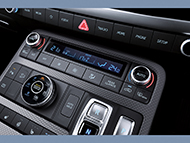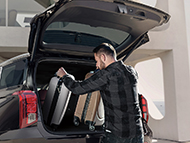By Lee Pang Seng
THERE’S a market for flagship SUVs (Sport Utility Vehicles) if someone very important is seeing using them, such as the Agong for one. Apparently, this has become the pull factor for the Hyundai Palisade, of which the facelift model was launched a few days before Chinese New Year.
The well-heeled wants to be seen in a vehicle that is apparently given the ‘Royal Seal of Approval’ through vehicle ownership, according to Hyundai-Sime Darby Motors Sdn Bhd (HSDM). With the growing number of inquiries for the Palisade, the Hyundai distributor felt the time was ripe to introduce the facelift model with its bolder looks.
The media was given a preview of the Palisade 2.2L Diesel shortly before the launch. Unfortunately, no drive impression was provided, even for once around the block in Ara Damansara, which would give the media a sampling of the vehicle’s performance, luxury ambience and ride comfort at its highest pedigree.
Hyundai-Sime Darby Motors first introduced the Palisade at the end of 2021, not long after the media drive preview of the Staria MPV (multipurpose vehicle). As a flagship SUV, the Palisade garnered its share of interest and 30 vehicles were sold since then.
Like the Staria, the Palisade is also sold on an order basis, that is, an order must be placed first before the vehicle is assembled in Hyundai, South Korea as per the buyer’s specifications. It is then shipped over and delivered in about three months’ time. It is this customised approach that has won sales from the elite circle.
The Palisade facelift is offered in the same model variation as per the pre-facelift model. This is the top most 3.8L V6 petrol and 2.2L turbodiesel, and each comes with two variants – an eight-seat Executive and seven-seat Luxury. HSDM feels that offering the flagship 3.8L model makes sense as the select clientele would enjoy the upper premium status more than worrying about high road tax.
The 3.8-litre Lambda GDi V6 is undersquarely configured with 87mm bore and 96mm stroke to displace 3778cc. Its output is rated at 216kW (295PS) at 6000rpm and 355Nm at 5200rpm. An eight-speed automatic transmission with E-Shift (shift by wire) channels engine output to the front wheels.
The 2.2-litre turbodiesel is a familiar unit having being used to power other Hyundai models such as the Santa Fe mid-range SUV and Staria. Engine output for the 2.2 CRDi in-line four is about the same too, despite being tweaked for the respective motoring need. This engine is also undersquare in configuration with 85.4mm bore and 96mm stroke to displace 2199cc. It delivers 147kW (200PS) at 3800rpm and high torque at 440Nm from 1750 to 2750rpm.
While the turbodiesel Palisade uses the same eight-speed automatic transmission with E-Shift as the petrol 3.8-litre V8, the engine power is delivered to all four wheels via an Active-on-Demand All-Wheel Drive system. Engine output is delivered between front and rear wheels as per road situation with 50:50 power delivery being the optimum scenario.
All four models on offer come with 20-inch alloy wheels, which are of a new design for the facelift Palisade. This is to give the lateral perspective a fresher look from the old and the tyres shod on them are 245/50 R20 rubbers. The Palisade comes with a full-size alloy wheel spare tyre. Its suspension system is a MacPherson strut front and multi-link rear.
Bold Aesthetic Updates
The Palisade’s facelift exercise covers the usual ground in styling changes to the front and rear that also saw some physical adjustments in the front and rear overhangs. Hyundai has opted for a bolder look to enhance the flagship SUV appeal. The black front grille flanked by restyled headlamp clusters does the job nicely, supported by design changes to the bumper and skid plates with metallic finishes for a rugged touch.
What strikes the eye immediately are the vertical arrangement of the LED (light emitting diode) daytime running lights, which are located on the outer flanks. The headlamp clusters now sit inside in an apparent switchover from the pre-facelift model. And what one would have assumed to be the headlamps in the sweeping light strips above actually house the turn indicators.
Likewise, the rear sees styling changes in the lamp combination clusters, reflectors, rear bumper and skid plates. While the 3.8L V6 would come with LEDs for the rear lights, Hyundai still retains light bulbs for the Palisade diesel models. The reasoning for that is best left to Hyundai. This Korean carmaker has also opted to place the twin chrome tailpipes side by side rather than one at each end as per the current trend.
These styling changes have seen to a 20mm longer overhang in front and slightly shorter 5mm overhang at the rear. Hyundai sees these changes as projecting a stronger stance and stabler appearance from a lateral perspective. The wheelbase stays the same at 2900mm.
Updates are also carried inside the Palisade cabin; steering wheel of a new design, bezel-less rearview mirror that is electro chromic, slim air vents running across the dashboard and 12.3-inch AVN display monitor to match the instrument cluster facing the driver.
The reasoning here for the same size display monitor is to provide a balanced and uniform look. Changes are also made in how they function. The large instrument cluster now serves merely as an information indicator while controls for the respective on-board functions are made on the AVN display monitor.
There are six drive modes to choose from via a large rotary knob on the central console for the 3.8L V6 while the 2.2L turbodiesel has nine due to its AWD system. The latter comes with HTRAC (Hyundai Traction) to optimise road traction as per the driving mode and road surface conditions. The three additional modes are for driving on snow, mud and sand.
All four models are equipped with a full range of safe driving systems along with passive safety features. An interesting one is the Multi-Collision Brake System that serves to minimise the impact of accidents. It is activated when one is driving below 180km/h and the brake and accelerator pedals are ‘scarcely used’. The system works by using the brakes selectively to bring the vehicle under control. It also deploys the airbags to minimise physical injury.
As facelift models, the latest Palisade is offered at a higher price than pre-facelift models. Starting at RM368,888 for the 2.2L Executive to RM399,888 for the 3.8L V6 Luxury, the price is RM40,000 higher on average. An interested customer has six exterior colours to choose from to pair with a choice of three interior colour and trim. And if you don’t mind paying a bit more, you could customise your Palisade further with additional equipment and trim. That’s an individualised flagship SUV well worth the wait over three months.











